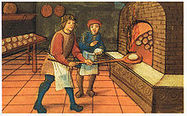Medieval cuisine includes the foods, eating habits, and cooking methods of various European cultures during the Middle Ages, a period roughly dating from the 5th to the 16th century. During this period, diets and cooking changed less across Europe than they did in the briefer early modern period that followed, when those changes helped lay the foundations for modern European cuisine.
Cereals remained the most important staples during the early Middle Ages, as rice was a late introduction to Europe and the potato was only introduced in 1536, with a much later date for widespread usage. Barley, oat and rye among the poor, and wheat for the governing classes, were eaten as bread,porridge, gruel and pasta by all members of society. Fava beans and vegetables were important supplements to the cereal-based diet of the lower orders. (Phaseolus beans, today the "common bean," were of New World origin and were introduced after the Columbian Exchange in the 16th century.)
Meat was more expensive and therefore more prestigious and in the form of game was common only on the tables of the nobility. The most prevalent butcher's meats were pork, chicken and other domestic fowl; beef, which required greater investment in land, was less common. Cod and herring were mainstays among the northern populations; dried, smoked or salted they made their way far inland, but a wide variety of other saltwater and freshwaterfish was also eaten.
Via Gust MEES



 Your new post is loading...
Your new post is loading...








Not medieval, but worth to visit to find good food with recipes:
- https://gustmeeshobbyfr.wordpress.com/2012/01/17/roulades-farcies-aux-choux/